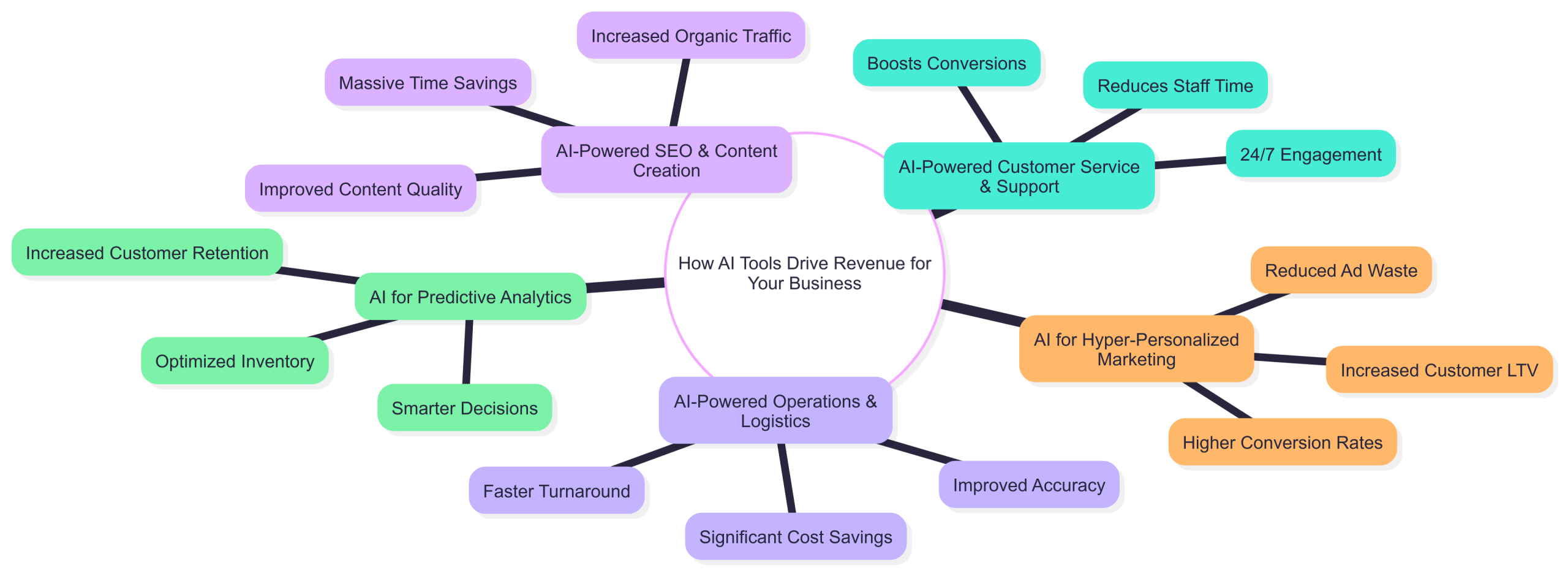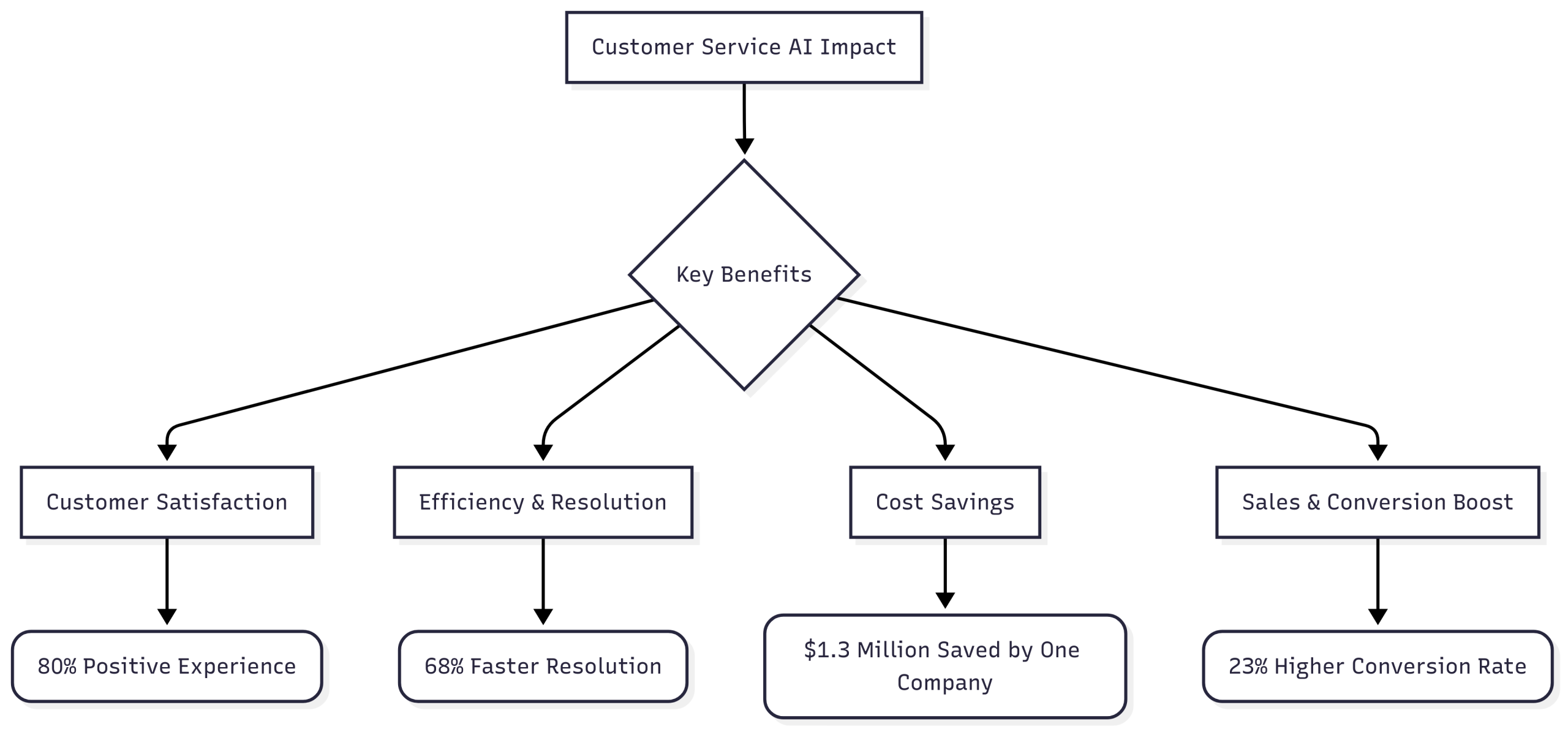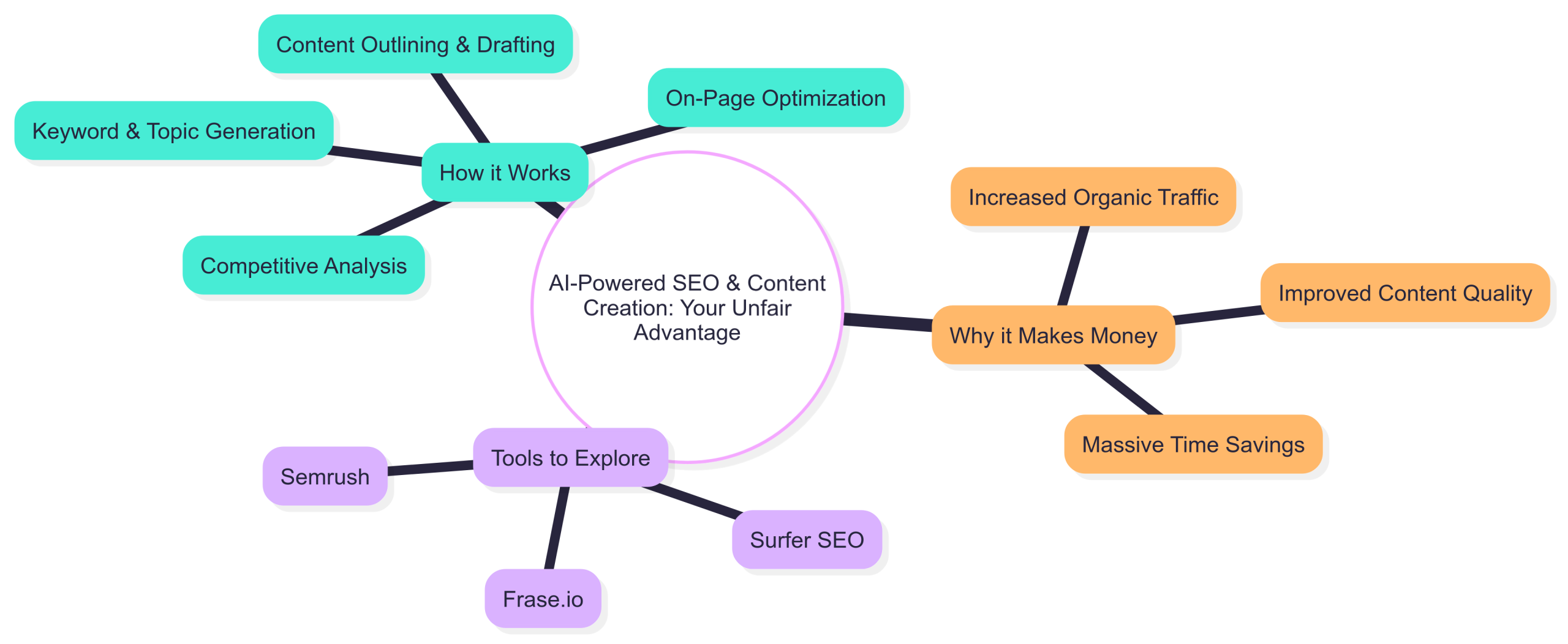Let’s cut to the chase. Of course you have heard about ChatGPT, automation, robots taking over the world 😀. As a busy business owner in Canada or the USA, what you really care about is: how does this stuff put money in my pocket or save me enough time that it feels like money?
Good news. There are tons of powerful, accessible AI tools available today that are directly impacting small and medium-sized businesses’ bottom lines.
Ready to see how? Let’s dive into the top 5 AI tools that are genuinely making a difference for businesses like yours.

1. AI-Powered Customer Service & Support: The 24/7 Sales Engine
Imagine this: It’s 2 AM, a potential customer lands on your website, has a burning question about your product, and gets an instant, helpful answer. No waiting, no lost lead. That’s the power of AI in customer service.
And this isn’t just about chatbots (though they’re part of it). We’re talking about AI-driven virtual assistants that can:
- Answer FAQs: Instantly resolve common queries, freeing up your human team for complex issues.
- Guide Users: Help visitors navigate your website, find specific products, or even complete a purchase.
- Qualify Leads: Ask key questions to understand a customer’s needs and pass warm leads directly to your sales team.
- Provide Instant Quotes: For service businesses, AI can gather information and provide immediate price estimates.
Why it makes money:
- Increased Conversions: Instant answers prevent customers from abandoning their carts or leaving your site.
- Reduced Overhead: Less time spent by staff on repetitive questions means more time for higher-value tasks.
- Enhanced Customer Satisfaction: Happy customers are returning customers, and they’re more likely to refer you.
Tools to explore:
Gilmedia Website Chatbot:
How it Works: Our Website Chatbot is designed to be your always-on sales and support agent. It uses Natural Language Understanding (NLU) to instantly engage website visitors in natural conversations. It understands their questions and either provides immediate, accurate answers from your knowledge base or guides them through a customized conversation flow.
This bot can qualify leads by asking targeted questions (e.g., “What type of service are you looking for?”, “What’s your budget?”), collect essential contact information, make product recommendations, and even provide guided assistance through your service pages. All this happens 24/7, ensuring no lead is missed, even outside business hours. You’ll receive email notifications with full conversation transcripts for qualified leads, and the system can integrate seamlessly with your CRM.
Drift:
How it Works: Drift is a conversational AI platform. It allows you to build AI-powered chatbots that engage website visitors in real-time. Instead of just “contact us,” users can chat directly with an AI bot that understands their questions. If the question is simple (“What are your hours?”), the AI answers. If it’s complex or signals high intent (“I need a quote for an HVAC installation next week!”), the AI can qualify them (ask for name, number, service type) and then hand off the conversation to a human sales rep during business hours, or schedule a call for later.
Zendesk Answer Bot:
How it Works: Integrated directly into Zendesk’s customer support platform, Answer Bot uses AI to understand incoming customer questions (from chat, email, or support tickets) and automatically suggests relevant articles from your help center. It can resolve common issues without human intervention or provide agents with quick access to information, drastically reducing response times.
Intercom Fin:
How it Works: Fin is Intercom’s AI bot specifically designed for support. It learns from your help center articles and past customer conversations to provide instant, human-like answers. It can answer follow-up questions, handle ambiguity, and resolve 50% or more of customer queries instantly, freeing up support teams.
Many customer service platforms now integrate AI capabilities directly. To see how AI can handle your calls too, check out our insights on the benefits of an AI Phone Virtual Receptionist.

2. AI for Hyper-Personalized Marketing: Speaking Directly to Every Customer
Remember when personalization meant just adding a customer’s first name to an email? AI takes that to a whole new level. It analyzes vast amounts of data (browse history, purchase patterns, demographics) to deliver truly individualized marketing messages.
How it works:
- Product Recommendations: “Customers who bought this also liked…” – AI fuels those perfectly timed suggestions on e-commerce sites.
- Dynamic Email Campaigns: Sending the right email, with the right offer, at the right time, based on individual user behavior.
- Ad Creative Optimization: AI can test thousands of ad variations (headlines, images, CTAs) simultaneously to find what resonates best with specific audience segments, maximizing your ad spend.
Why it makes money:
- Higher Conversion Rates: Relevant offers are more likely to convert.
- Increased Customer Lifetime Value (CLTV): Personalization fosters loyalty and repeat purchases.
- Wasted Ad Spend Reduction: AI fine-tunes targeting and messaging, ensuring your budget goes further.
Tools to explore:
Mailchimp (AI features for email/landing pages):
How it Works: Mailchimp integrates AI to help you optimize your email marketing. Its AI-powered “Creative Assistant” can generate design ideas for emails and landing pages. Its segmentation tools use AI to help you identify optimal audience groups, and its “Send Time Optimization” uses data to predict the best time to send an email for maximum opens and clicks based on your specific audience.
Optimizely (for personalization and A/B testing with AI insights):
How it Works: Optimizely is a powerful experimentation platform. Its AI analyzes how different user segments interact with your website or app. It then uses these insights to automatically personalize content, product recommendations, and user paths in real-time. For example, it can dynamically change the homepage banner a visitor sees based on their Browse history or demographic data to maximize their engagement and likelihood to convert.
Or you can use many e-commerce platforms like Shopify that have built-in AI recommendation engines.
3. AI-Powered SEO & Content Creation: Your Unfair Advantage on Google
You know SEO is vital, but keyword research, content creation, and optimization can be a huge time sink. AI is transforming this, giving smaller businesses the tools to compete with bigger players.
How it works:
- Keyword & Topic Generation: AI can rapidly identify untapped keyword opportunities and trending topics in your niche that your competitors might be missing.
- Content Outlining & Drafting: Generate comprehensive outlines, create compelling headlines, and even draft entire sections of content (which you then refine and fact-check, of course!).
- On-Page Optimization: AI tools can analyze your content and suggest improvements for readability, keyword density, and technical SEO elements.
- Competitive Analysis: Get lightning-fast insights into your competitors’ SEO strategies and content gaps.
Why it makes money:
- Increased Organic Traffic: Better-optimized content ranks higher, bringing more free traffic to your site.
- Massive Time Savings: Dramatically cuts down the time spent on research and initial drafting.
- Improved Content Quality: AI can help ensure your content is comprehensive and authoritative, meeting user intent.
Tools to explore:
Surfer SEO:
How it Works: Surfer SEO analyzes the top-ranking pages for your target keyword. It then uses AI to provide data-driven recommendations on content length, keyword usage (including related terms), heading structure, and competitor analysis. You write your content, and Surfer gives you a real-time “Content Score” to guide you on how well-optimized it is compared to the top results, ensuring you cover all the key topics Google expects for that search query.
Frase.io:
How it Works: Frase.io excels at content research and outlining. You give it a target keyword, and Frase uses AI to instantly generate comprehensive content briefs, identifying common questions asked, related topics, and key statistics from the web. It can also help you draft sections of content, summarize findings, and even rewrite sentences to improve clarity or tone.
Semrush (with its AI features for content creation/optimization):
How it Works: Semrush is a comprehensive SEO suite, and it’s rapidly integrating AI across its tools. Its “Content Marketing Toolkit” includes an “SEO Content Template” that uses AI to analyze top-ranking content and provide recommendations for target keywords, readability, and ideal content length. Its “Content AI” feature can help you brainstorm topics, generate outlines, and even write initial drafts directly within the platform.

4. AI for Predictive Analytics: Seeing the Future to Boost Sales
This sounds like science fiction, but it’s becoming a reality for SMBs. AI can analyze historical data to predict future trends, customer behavior, and even potential problems.
How it works:
- Sales Forecasting: Predict future sales volumes, helping you manage inventory and staffing more efficiently.
- Churn Prediction: Identify customers who are at risk of leaving, allowing you to intervene with targeted retention efforts.
- Demand Planning: Optimize your supply chain by accurately forecasting product demand.
- Customer Segmentation: Group customers based on likely future behavior, allowing for highly targeted marketing and sales efforts.
Why it makes money:
- Optimized Inventory: Reduces waste and stockouts, improving cash flow.
- Increased Customer Retention: Keeping existing customers is cheaper than acquiring new ones.
- Smarter Business Decisions: Move from reactive to proactive strategies, minimizing risks and maximizing opportunities.
Tool to explore:
Salesforce Essentials:
How it Works: Salesforce Essentials, designed for small businesses,uses AI (their “Einstein AI”) to analyze your CRM data. It can predict which leads are most likely to convert, which customers are at risk of churning, and even suggest the best next steps for your sales team. This takes the guesswork out of prioritizing leads and managing customer relationships.
Zoho CRM:
How it Works: Zoho CRM includes “Zia,” its AI-powered assistant. Zia helps with predictive sales forecasting by analyzing your pipeline and past deals. It can also identify anomalies in data, recommend optimal times to contact customers, and even suggest macros or workflows to automate repetitive tasks based on your usage patterns.
Also, look at platforms like Tableau or Power BI which are adding AI for easier data analysis and prediction.
5. AI-Powered Operations & Logistics: Streamlining Your Workflow
Beyond marketing and sales, AI is making everyday business operations smoother, faster, and more cost-effective.
How it works:
- Automated Data Entry: AI can read invoices, receipts, and forms, automatically inputting data into your systems, eliminating manual work.
- Scheduling Optimization: For service businesses, AI can optimize technician routes or appointment schedules, saving fuel and time.
- Quality Control: In manufacturing or logistics, AI-powered computer vision can identify defects or inconsistencies faster and more accurately than the human eye.
- Resource Allocation: AI helps allocate staff or resources to projects based on workload and predicted needs.
Why it makes money:
- Significant Cost Savings: Reduces manual labor, errors, and operational inefficiencies.
- Improved Accuracy: AI often performs repetitive tasks with higher precision than humans.
- Faster Turnaround Times: Streamlined processes mean you can serve more customers, quicker.
Tool to explore:
Zapier (with AI integrations):
How it Works: Zapier is an automation tool that connects thousands of apps. With its growing AI integrations, you can set up “Zaps” where AI performs a task. For instance, when a new lead comes in from your website, Zapier can send it to an AI tool to extract key information (e.g., service needed, urgency), then send that summarized info to your CRM or even schedule a follow-up task. It’s about automating cross-platform tasks using AI to make decisions or process information.
The Bottom Line: AI Isn’t Just “Nice to Have” Anymore
For Canadian and US business owners, using AI is rapidly moving from an option to a necessity. The tools listed above aren’t futuristic concepts; they are practical, accessible solutions designed to:
- Boost your revenue.
- Slash your operational costs.
- Save you invaluable time.
- Keep you competitive.
The key isn’t to replace your team with robots, but to empower your team with intelligent tools. Start small, experiment with one or two areas where you feel the most pain, and watch how these AI assistants start putting real money back into your business.
Ready to explore how AI and other digital strategies can transform your business?
Contact Gilmedia today for a personalized consultation!


